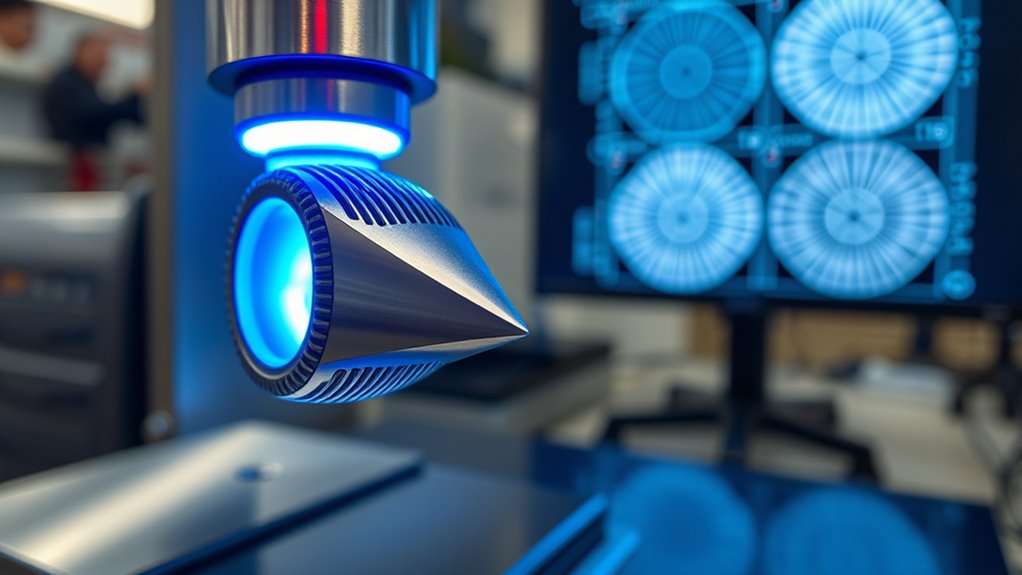If you’re looking for the best fiber optic inspection microscopes in 2025, I recommend checking out models with 400x magnification, bright LED illumination, and versatile adapters for various connector types. Portability, durable build, and user-friendly features like adjustable focus and data recording are essential. Reputable brands offer reliable performance for professional inspections and maintenance. Keep exploring, and you’ll discover the key factors to choose the perfect tool for your needs.
Key Takeaways
- Top-rated fiber optic inspection microscopes with 400x magnification for detailed end-face analysis in 2025.
- Models featuring versatile adapters for various connector types (LC, SC, FC, ST, MPO) ensuring compatibility.
- Devices with high-definition displays, real-time video streaming, and image capture for precise diagnostics.
- Portable, durable designs with ergonomic features and long battery life suited for field and laboratory use.
- Advanced illumination, focus controls, and data management options to enhance inspection accuracy and efficiency.
Handheld Fiber Optic Microscope Inspection Tool with Adapters
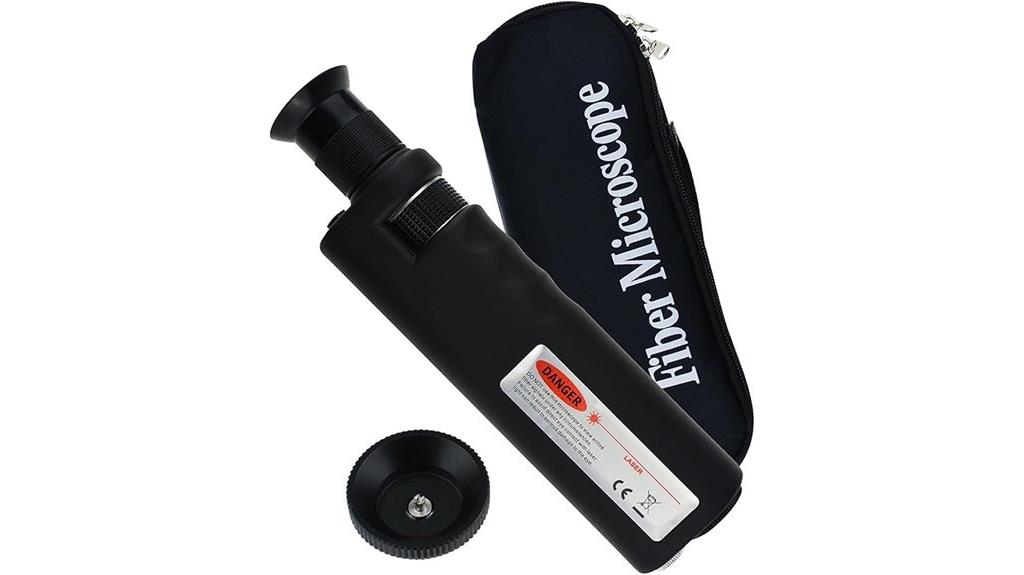
If you’re looking for a reliable, portable tool to inspect fiber optic connectors, the Handheld Fiber Optic Microscope Inspection Tool is an excellent choice. It offers 400x magnification, revealing intricate details of fiber end-faces, perfect for hobbyists and professionals alike. The built-in LED illumination guarantees clear visuals, even in low light. It includes 2.5mm and 1.25mm adapters, making it versatile for different connectors like FC, SC, and LC. Designed with a non-slip rubber housing for stability, it’s lightweight at just 1.63 pounds. While adjustment can be tricky, its durability and sharp imaging make it a cost-effective option for fiber inspection.
Best For: hobbyists and professionals seeking a portable, high-magnification fiber optic inspection tool for detailed end-face analysis.
Pros:
- Provides clear, sharp images at 400x magnification, suitable for detailed fiber inspections
- Comes with versatile adapters (2.5mm and 1.25mm) for compatibility with various fiber connectors
- Durable, lightweight design with non-slip rubber housing enhances stability and ease of use
Cons:
- Adapter adjustments can be time-consuming and may require precise alignment
- Rubber housing can slip during operation, affecting stability
- Internal dust and hairs may be visible during focus adjustments, potentially affecting image clarity
Fiber Optic Inspection Microscope 400x LED Illumination
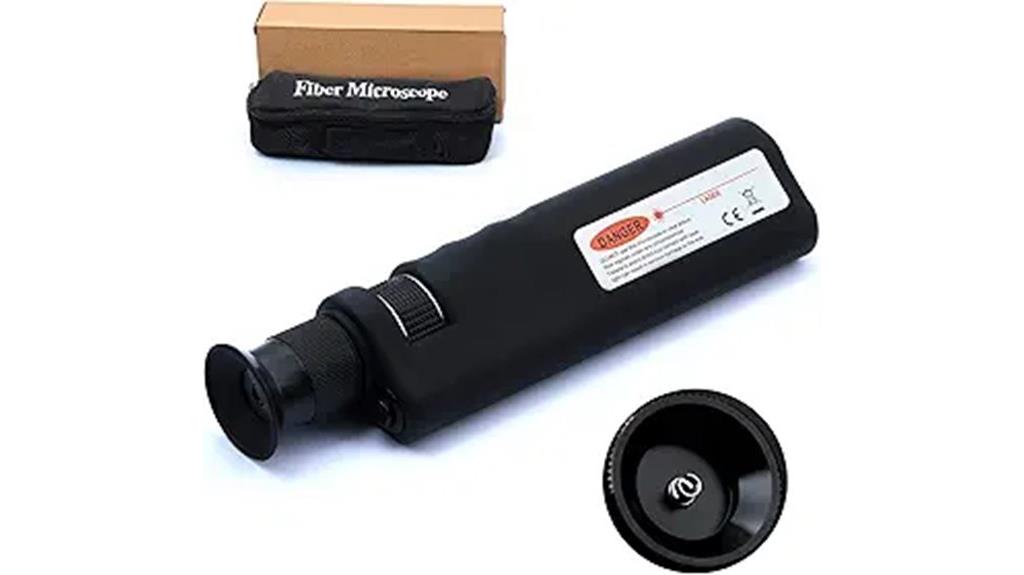
The Fiber Optic Inspection Microscope 400x LED Illumination is an ideal tool for technicians and professionals who need precise, high-quality inspections of fiber optic connectors. Its 400x magnification, optical zoom, and smooth focus allow detailed examinations of SC, LC, and FC cables. The built-in LED provides bright, consistent lighting rated for 100,000 hours, while the IR filter guarantees eye safety. Its compact, handheld design with an anti-slip grip makes inspections comfortable and accurate. Quick light switching and versatile adapters enhance usability. Although batteries are not included, its performance makes it a reliable choice for ensuring fiber optic connections meet strict quality standards.
Best For: technicians and professionals who require precise, high-quality fiber optic inspections for maintaining and troubleshooting fiber optic connections.
Pros:
- Provides 400x magnification with optical zoom for detailed inspections.
- Built-in LED illumination rated for 100,000 hours ensures bright, consistent lighting.
- Compact, handheld design with anti-slip grip enhances comfort and ease of use.
Cons:
- Batteries are not included, requiring additional purchase.
- Customer rating indicates mixed reviews, suggesting variability in user experience.
- Limited to specific adapters (2.5mm and 1.25mm), which may not cover all connector types.
400X Fiber Optic Microscope with LED Lighting
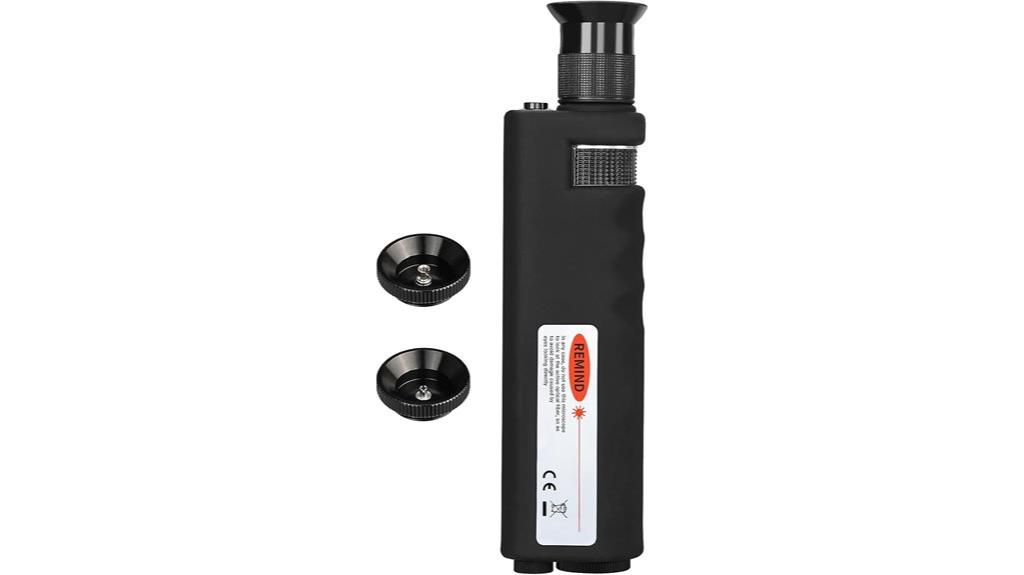
Designed for technicians and professionals who need reliable fiber optic inspection tools, the 400X Fiber Optic Microscope with LED lighting offers precise, clear visualization of fiber interfaces. Its handheld design makes inspections quick and convenient, while the 1.25mm and 2.5mm adapters ensure compatibility with various fiber types like SC, FC, ST, and LC. The bright LED illumination enhances visibility, even in low-light conditions, and the fiber optic lens provides sharp, detailed images. Lightweight and comfortable to hold, this microscope simplifies cleaning and measurement tasks, making it an essential tool for maintaining ideal fiber optic performance.
Best For: technicians and professionals requiring reliable, precise fiber optic inspection tools for quick and detailed fiber interface analysis.
Pros:
- Provides clear, sharp images with fiber optic lens and LED illumination.
- Compatible with multiple fiber types using 1.25mm and 2.5mm adapters.
- Lightweight, handheld design for easy handling and quick inspections.
Cons:
- Limited to 400X magnification, which may not suit all detailed inspection needs.
- Requires proper cleaning and maintenance to ensure optimal performance.
- Only available in one color and design, lacking customization options.
Jonard Tools FIM-400 Fiber Optic Inspection Microscope

For professionals seeking detailed fiber end inspections, the Jonard Tools FIM-400 Fiber Optic Inspection Microscope stands out with its 400x magnification and high-quality achromatic lens. It offers sharp, clear images of fiber ends, residues, and ferrules, making it ideal for pre- and post-cleaning checks. The coaxial illumination and laser filters ensure eye safety and superior visibility. With adapters for most connector types and a focus wheel for precise adjustments, it’s user-friendly and durable. Compact and CE certified, the FIM-400 is a reliable choice for both beginners and experts, delivering professional-grade inspection in a portable, robust design.
Best For: professionals and technicians seeking high-resolution, precise fiber end inspection for quality control and maintenance.
Pros:
- Provides sharp, detailed images at 400x magnification with high-quality achromatic lens.
- Includes versatile adapters for most common fiber connector types, enhancing compatibility.
- Durable, compact design with coaxial illumination and laser filters for eye safety.
Cons:
- LED brightness may be too intense for some users; lacks adjustable intensity controls.
- Focus wheel can be challenging at high magnification to view entire fiber end.
- Does not support 3.15 mm fiber connectors without modification, requiring custom adjustments.
Fiber Optic Inspection Video Probe A-600
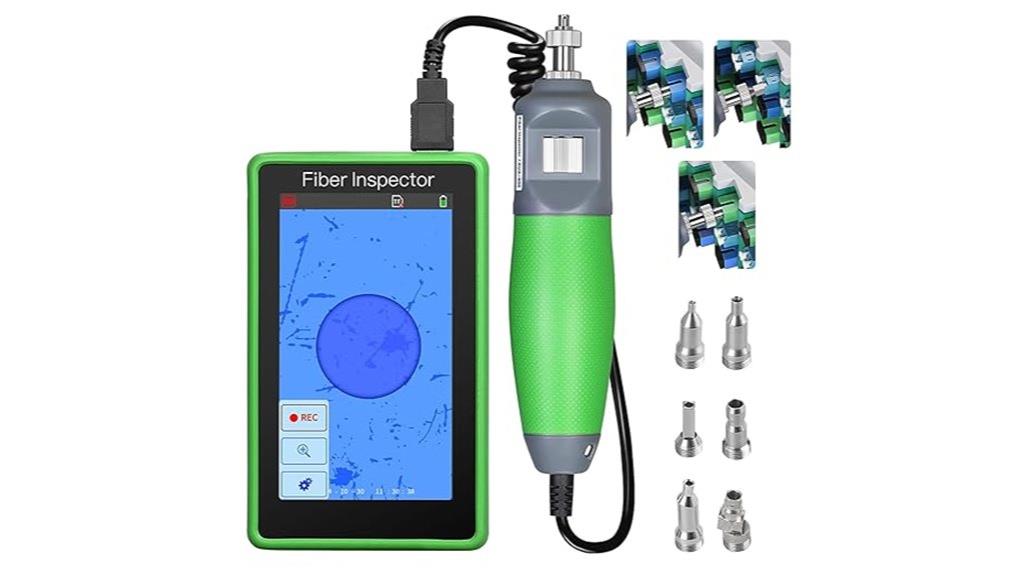
If you’re looking for a reliable inspection tool that offers detailed fiber analysis on the go, the Fiber Optic Inspection Video Probe A-600 stands out. It features a 5-inch high-definition touch screen and supports multiple connector types, including SCUPC, FCUPC, STUPC, LCUPC, and SCAPC, thanks to its versatile adapters. With 400x magnification, it provides clear views of fiber end faces to identify dirt, damage, or defects. Its ability to record videos, capture images, and export data via USB makes documentation easy. The device’s durable silicone shell and long-lasting battery ensure reliable outdoor use, making it a versatile choice for field inspections.
Best For: technicians and field engineers requiring portable, high-precision fiber optic inspection and documentation in outdoor or remote environments.
Pros:
- Supports multiple fiber connector types with versatile adapters for broad compatibility
- High 400x magnification ensures detailed examination of fiber end faces for cleanliness and damage
- Long-lasting 20-hour battery and durable silicone shell make it ideal for outdoor and field inspections
Cons:
- Requires external USB connection for live viewing and data export, which may limit mobility in certain scenarios
- The 5-inch screen, while high-definition, might be small for detailed analysis over extended periods
- No mention of built-in measurement or analysis tools beyond recording and image capture, potentially limiting advanced diagnostics
Handheld Optical Fiber Microscope with Adapters
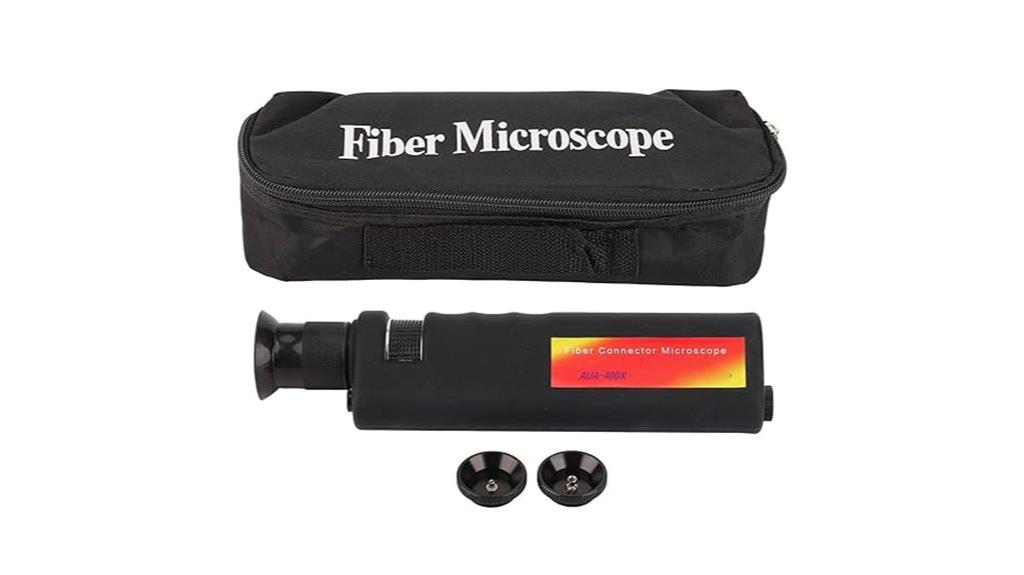
Are you searching for a versatile fiber optic inspection tool that works seamlessly across different connectors? The Handheld Optical Fiber Microscope with Adapters is designed for wide compatibility, featuring 2.5mm and 1.25mm adapters to fit SC, FC, ST, and LC interfaces. Its imported lens delivers sharp, bright images with dustproof and waterproof protection, plus laser filters to safeguard your eyes. With 400x magnification, it reveals micro-level details, making troubleshooting easier. Built from durable ABS and aluminum alloy, it’s sturdy and comfortable to hold. The simple on/off button and smooth focus control make inspections quick and efficient, ideal for both professionals and enthusiasts.
Best For: professionals, amateurs, and enthusiasts seeking a versatile and durable optical fiber inspection tool compatible with various connector types.
Pros:
- Wide compatibility with SC, FC, ST, and LC interfaces thanks to 2.5mm and 1.25mm adapters.
- High-quality imported lens with 400x magnification for detailed micro-level inspections.
- Durable construction using ABS and aluminum alloy, with slip-proof rubber shell for comfort and safety.
Cons:
- May be more expensive than basic fiber inspection tools.
- Requires some familiarity with fiber optic connectors for optimal use.
- Limited to handheld operation without additional stabilization accessories.
Fiber Optic Inspection Video Probe A-600

The Fiber Optic Inspection Video Probe A-600 stands out with its 5-inch high-definition touchscreen, making it ideal for technicians who need quick, clear insights during fiber optic inspections. It supports multiple connector types, including SCUPC, FCUPC, STUPC, LCUPC, and SCAPC, with an adapter for thorough compatibility. The 400x magnification provides detailed views of fiber end faces, ensuring cleanliness and detecting damage. It offers real-time video recording, image capture, and data logging, which can be exported via USB. Powered by a 4000mAh battery with a 20-hour standby, its durable shell makes it suitable for outdoor use, combining precision and reliability.
Best For: technicians and field engineers who require precise, portable fiber optic inspection tools for maintaining and troubleshooting various fiber connector types in diverse environments.
Pros:
- Supports multiple fiber connector interfaces including SCUPC, FCUPC, STUPC, LCUPC, and SCAPC, ensuring broad compatibility.
- Equipped with a high-definition 5-inch touch screen and 400x magnification for detailed, real-time inspections.
- Features long battery life (up to 20 hours) and durable, protective design suitable for outdoor and on-site use.
Cons:
- The device may be relatively costly compared to simpler inspection tools.
- Requires familiarity with fiber optic inspection procedures for optimal use.
- Limited to 5-inch display size, which might be small for some detailed inspection needs.
Fiber Optic Inspection Microscope with Adapters and Cleaner

Designed for technicians who need quick and accurate fiber end face inspections, the Fiber Optic Inspection Microscope with Adapters and Cleaner offers versatile compatibility and user-friendly features. It supports 2.5mm and 1.25mm configurations, fitting SC, FC, ST, and LC interfaces, making it suitable for various fiber types. The device features a comfortable grip, plug-and-play operation, and fiber optic lenses for precise detection. It’s dustproof, waterproof, and powered by 3 AAA batteries. Plus, it includes a handheld LED cleaner for maintenance. This microscope provides fast, reliable inspections in both field and lab environments, ensuring excellent fiber performance.
Best For: technicians and field engineers who require quick, accurate, and versatile fiber end face inspections in both laboratory and field environments.
Pros:
- Supports multiple fiber interface types (SC, FC, ST, LC) with included adapters for versatile use
- Compact, lightweight design with a comfortable grip for easy handling and quick inspections
- Comes with a handheld LED cleaner for easy maintenance and cleaning of fiber end faces
Cons:
- Battery-powered operation may require frequent replacements or recharging
- Limited to 3 AAA batteries, which might not last long during extensive use
- May require some training for optimal use of fiber optic lenses and inspection techniques
Komshine Fiber Optic Inspection Video Probe (KIP-600V)
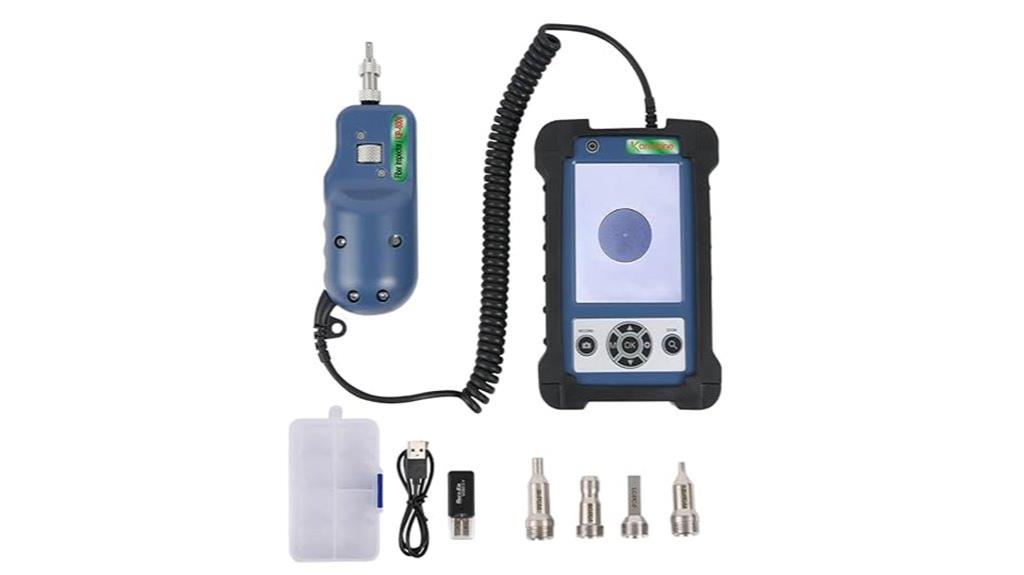
If you need a portable and easy-to-use fiber optic inspection tool, the Komshine KIP-600V stands out with its compact design and high-quality imaging. Its 3.5-inch HD LCD display provides 400x magnification, making it easy to spot stains and pollution. The device’s ergonomic shape allows for one-handed operation, perfect for fieldwork. With a 1/3-inch sensor and various connector support—including FC, SC, ST, and LC—it’s versatile for different inspections. Plus, it records videos in real time, stores data on a TF card, and offers up to 20 hours of battery life, ensuring reliable performance anywhere.
Best For: technicians and field engineers needing a portable, high-quality fiber optic inspection tool for quick and accurate inspections in various environments.
Pros:
- Compact and ergonomic design for easy one-handed operation.
- High-resolution HD LCD display with 400x magnification ensures clear visualization of stains and pollution.
- Versatile connectivity with multiple fiber optic connector support and real-time video recording capabilities.
Cons:
- Limited to 20 hours of battery life, which may be insufficient for very long inspections without recharging.
- Might require familiarity with different connector types for optimal use.
- The device’s size and features may be less suitable for highly detailed or professional laboratory inspections.
4-Piece Fiber Cleaning Tool Kit and Microscope Set

A 4-piece fiber cleaning toolkit and microscope set stands out as an essential choice for technicians and professionals who need precise, reliable cleaning and inspection tools. It includes a handheld 400x magnifying glass compatible with SC/FC/ST/LC connectors, a fiber jumper end face cleaning box, and a one-click cleaning pen. The magnifier features replaceable interfaces and offers six functional features like waterproofing and safety eye protection. The cleaning tools are durable—capable of approximately 550 uses—ensuring thorough, safe maintenance. Compact and easy to use, this set enhances inspection accuracy and simplifies fiber optic cleaning, making it an invaluable addition for any high-precision testing environment.
Best For: technicians and professionals requiring precise fiber optic cleaning and inspection tools for high-accuracy testing and maintenance.
Pros:
- Durable and capable of approximately 550 uses, ensuring long-term reliability.
- Features a 400x magnifying glass compatible with multiple fiber connector types for versatile inspection.
- Compact design with multiple safety and functional features, enhancing ease of use and safety.
Cons:
- Slightly higher initial cost compared to basic cleaning kits.
- The magnifying glass replacement interfaces may require careful handling to avoid damage.
- Limited to fiber optic cleaning and inspection, not suitable for other electronic or hardware maintenance.
14 in 1 Fiber Optic Cleaning Tool Kit with Microscope and Cleaning Boxes
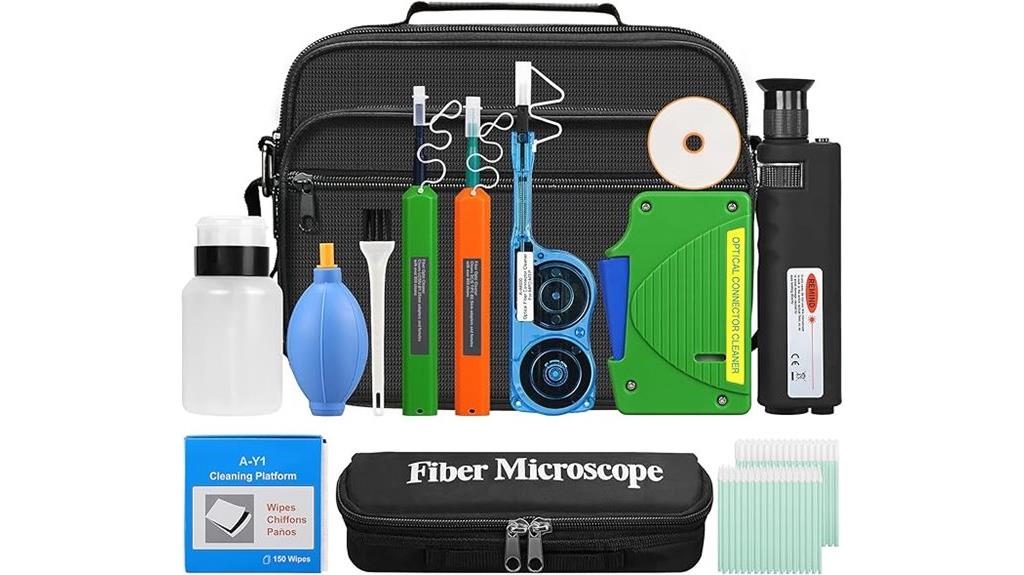
The 14-in-1 Fiber Optic Cleaning Tool Kit with Microscope and Cleaning Boxes is perfect for technicians who need a thorough solution for inspecting and maintaining fiber optic connections. It includes a 400x optical microscope, versatile cleaning tools, and replacement components like fiber cleaning boxes and pens, supporting multiple connector types. The kit’s lightweight design makes it easy to carry and use on-site, while the microscope enables detailed inspection of connectors for dirt, scratches, or damage. The cleaning components ensure thorough removal of contaminants, helping maintain ideal signal quality. Overall, this all-in-one tool set simplifies fiber optic maintenance, saving time and ensuring high performance.
Best For: technicians and professionals who require a comprehensive, portable solution for inspecting, cleaning, and maintaining fiber optic connectors to ensure optimal signal quality and device performance.
Pros:
- Includes a 400x optical microscope for detailed inspection of fiber connectors.
- Equipped with a variety of cleaning tools and replacement components for different connector types.
- Lightweight and portable design makes it convenient for on-site use and quick maintenance.
Cons:
- Constructed primarily from paper, which may affect durability over time.
- Slightly higher price point compared to basic cleaning kits without inspection tools.
- Limited to fiber optic cleaning; not suitable for other types of electronic or network components.
YICIZOL Fiber Optic Cleaning Inspection Kit

Designed for professionals who need quick and reliable fiber end-face inspection, the YICIZOL Fiber Optic Cleaning Inspection Kit features a compact, one-handed 400x microscope compatible with LC, FC, SC, and ST connectors. Its small size and ergonomic design allow for fast, single-handed operation, making fiber maintenance efficient. The kit includes cleaning pens, sticks, and a cassette, supporting thorough cleaning of fiber end-faces, splice prep, and adapters. With durable, anti-static tools and over 550 cleaning cycles, it guarantees peak network performance. Plus, a one-year warranty and lifetime support add confidence to your investment. This kit is ideal for maintaining high-quality fiber connections in professional settings.
Best For: professional fiber optic technicians seeking quick, reliable inspection and cleaning tools to maintain optimal network performance.
Pros:
- Compact, ergonomic design allows for one-handed, quick inspections.
- Includes a variety of cleaning tools with over 550 cleaning cycles for cost-effective maintenance.
- Compatible with multiple connector types (LC, FC, SC, ST, MU, MPO, MTRJ), suitable for diverse fiber optic applications.
Cons:
- The microscope requires batteries, which are not included, potentially adding to the cost.
- Some users have reported performance issues with the microscope, attributed to manufacturer defects.
- Slightly larger size of cleaning sticks may be less precise for very tight or delicate connector spaces.
Fiber Inspection Camera with 3.5-inch HD LCD Display and Tips

If you’re seeking a reliable fiber inspection solution, this camera stands out with its powerful 400x magnification and real-time video probe, making it ideal for technicians who need precise, high-resolution imaging. Its 3.5-inch HD LCD display provides clear visuals, while the user-friendly interface simplifies operation. Equipped with a 1/3 inch sensor and 300,000 pixels, it captures detailed images of fiber end-faces and pollution. The camera supports data recording, measurement review, and pollution checks. With a 4000mAh battery offering up to 20 hours of use and various tips for different connectors, it’s portable, versatile, and perfect for field inspections.
Best For: technicians and field professionals requiring high-resolution, portable fiber end-face inspection with real-time video capabilities.
Pros:
- High 400x magnification with real-time video probe for detailed inspection.
- 3.5-inch HD LCD display ensures clear, easy-to-interpret visuals.
- Long-lasting 20-hour battery and versatile tips for various connector types.
Cons:
- May require training for optimal use of measurement and pollution assessment features.
- Limited to specific connector types unless additional tips are purchased.
- The device’s compact size might be challenging for users with larger hands or gloves.
Factors to Consider When Choosing a Fiber Optic Inspection Microscope
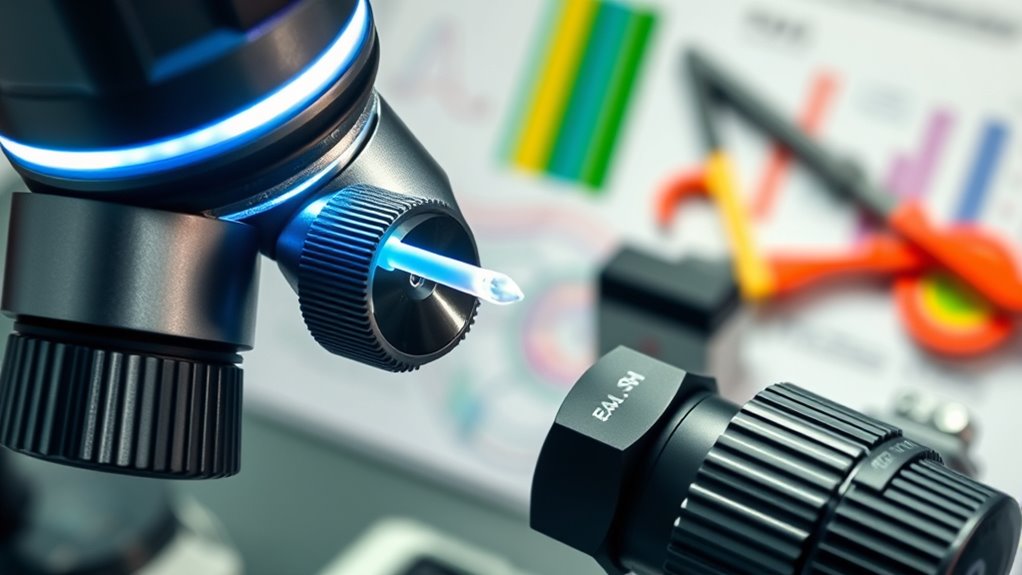
When selecting a fiber optic inspection microscope, I focus on several key factors to guarantee it meets my needs. I consider the magnification power, compatibility with different connectors, and the quality of illumination features. Additionally, I look for ease of focus adjustment, portability, and a practical design to make my inspections efficient and comfortable.
Magnification Power Needs
Choosing the right magnification power is essential for effective fiber optic inspection because it determines how well you can see tiny defects and contaminants on fiber end-faces. Higher magnifications, like 400x, enable detailed views of dust, scratches, and dirt particles that could impair signal quality. Adequate magnification is crucial for spotting microscopic flaws that might compromise network performance. If the magnification is too low—below 200x—you risk missing small contaminants or flaws, leading to incomplete assessments. The chosen magnification should match your inspection purpose; high-precision tasks demand higher magnification than routine cleaning. Additionally, optical clarity at your selected magnification ensures you can accurately interpret fiber conditions without distortion or loss of detail, which is essential for proper diagnostics.
Compatibility With Connectors
Selecting a fiber optic inspection microscope that is compatible with your connectors is essential for accurate diagnostics. I check that it includes adapters suitable for your connector types, like SC, LC, FC, or ST. It’s also important that the device supports the connector sizes specific to your network, usually 1.25mm or 2.5mm. If you work with both polished (UPC) and angled (APC) connectors, confirm the microscope supports both or offers the necessary adapters. Additionally, consider if the scope accommodates duplex connectors or only supports simplex configurations, as some models require separation of individual fibers. Ensuring compatibility prevents measurement errors and saves time during inspections, making your testing process more efficient and reliable.
Illumination Quality Features
High-quality fiber optic inspection microscopes incorporate advanced illumination features that are essential for accurate diagnostics. Built-in LED lights rated for up to 100,000 hours provide bright, reliable illumination without frequent replacements. Adjustable brightness lets me tailor the light intensity, ensuring clear visibility of fiber end-faces, contaminants, or damages. Laser or IR security filters enhance eye safety by reducing harmful light exposure, allowing me to focus without concern. Uniform, shadow-free lighting is pivotal for revealing dust, scratches, or defects that could compromise signal integrity. Bright, consistent illumination combined with precise focusing capabilities enables detailed microscopic inspections, improving both accuracy and confidence in my assessments. These illumination features are essential for achieving reliable results during fiber optic testing and maintenance.
Ease of Focus Adjustment
When evaluating fiber optic inspection microscopes, I find that ease of focus adjustment is essential for efficient and accurate inspections. A good microscope should have smooth, precise focus wheels or knobs that allow fine-tuning without sudden jumps or resistance. The focus mechanism needs to be responsive and require minimal force, so I can quickly achieve clear views of fiber end-faces. Stability is crucial; once focused, the image shouldn’t drift during inspection. I also look for adjustable focus controls that are ergonomically positioned, making prolonged use comfortable. High-quality models often include adjustable zoom or focus screws, enabling incremental changes for sharp images across various inspection distances. Overall, effortless focus adjustment saves time and improves inspection accuracy, making it a vital factor in my selection process.
Portability and Design
A portable fiber optic inspection microscope needs to be both compact and lightweight to make fieldwork manageable. I look for devices under 2 pounds, so carrying them around is effortless. An ergonomic shape with non-slip rubber housing helps me grip the microscope securely, reducing fatigue and slip risks during inspections. Features like foldable or retractable handles and foldable eyepieces boost portability without sacrificing performance. Durability is vital, so I favor impact-resistant casings that can withstand rough outdoor conditions. Additionally, integrated batteries with a long-lasting capacity—over 20 hours—and quick-charge or USB options are essential for extended use in remote locations. These design elements ensure I can perform precise inspections efficiently, regardless of where I am.
Battery Life Duration
Choosing a fiber optic inspection microscope with sufficient battery life is essential for maintaining productivity during fieldwork or long maintenance sessions. Longer battery life means I can perform inspections without frequent recharging, which is especially important in remote locations. Devices with high-capacity batteries, like 4000mAh, can last up to 20 hours, reducing downtime and keeping workflows smooth. Shorter battery durations force me to carry extra batteries or find power sources, delaying progress. Rechargeable lithium-ion batteries are preferable because they offer better longevity and steady power output compared to disposable options like AA batteries. Additionally, quick recharge times help me stay operational and avoid interruptions during critical inspections. Overall, battery life directly impacts efficiency and the ability to complete tasks without unnecessary stops.
Cost and Brand Reliability
Investing in a fiber optic inspection microscope from a reputable brand guarantees you get reliable performance and quality that meets industry standards. Established brands with certifications usually deliver products that are safer, more durable, and better aligned with professional requirements. Higher-cost models from trusted manufacturers often feature superior optical clarity, longer lifespan, and enhanced durability compared to cheaper, lesser-known alternatives. To gauge brand reliability, I look at customer reviews, ratings, and the company’s track record for support and warranty services. Trusted brands also incorporate advanced features like eye safety filters and precise focusing mechanisms, ensuring consistent inspection results. Ultimately, choosing a reputable brand reduces the risk of equipment failure and costly replacements, offering better long-term value and peace of mind for professional use.
Frequently Asked Questions
What Is the Optimal Magnification Level for Different Fiber Testing Scenarios?
The ideal magnification level varies depending on the fiber testing scenario. For general inspection, I recommend 200x to 400x magnification, offering a clear view of core and cladding features. When examining connectors or detecting defects, go up to 1000x to identify minute imperfections. Lower magnifications, around 50x to 100x, are useful for quickly scanning large areas. Adjust based on detail needed for accurate, efficient testing.
How Does LED Illumination Impact Image Clarity During Fiber Inspection?
Imagine inspecting ultra-fine fiber cores; LED illumination makes a huge difference. It enhances image clarity by providing bright, consistent light that reveals even tiny defects. In my experience, LED lighting reduces glare and shadows, allowing for sharper details and more accurate assessments. This means I can spot flaws quickly, saving time and ensuring top-quality fiber connections. LED illumination truly elevates the precision of fiber inspections.
Which Accessories Are Essential for Comprehensive Fiber Optic Testing?
I believe essential accessories for thorough fiber optic testing include high-quality cleaning tools to keep connectors spotless, adjustable illumination sources for clear imaging, and precision adapters for accurate connections. A portable power supply ensures mobility, while a storage case protects your equipment. I also recommend a calibration kit to maintain accuracy over time. These accessories collectively improve testing efficiency and ensure reliable, precise measurements.
How Do Handheld Microscopes Compare to Benchtop Models in Accuracy?
Think of handheld microscopes as agile explorers, perfect for quick checks, but they might miss the fine details that a benchtop model captures like a hawk with sharp eyes. Benchtops offer stability and higher precision, making them ideal for detailed inspections. While handhelds are portable and handy, if accuracy is your mission, I lean towards benchtop microscopes—they’re the steady hand guiding you to flawless fiber optic testing.
What Maintenance Routines Ensure Longevity of Fiber Inspection Microscopes?
To keep my fiber inspection microscope in top shape, I regularly clean the lenses with proper optical wipes and avoid touching the glass surfaces. I also guarantee the device is stored in a dust-free environment and calibrate it periodically to maintain accuracy. Additionally, I check for loose parts or damage and handle it carefully to prevent accidental falls or impacts, which can extend its lifespan.
Conclusion
Just like a skilled detective illuminates the hidden clues, choosing the right fiber optic inspection microscope can reveal the tiniest flaws with crystal-clear precision. With the right tool in hand, you’ll uncover a world of unseen details, ensuring flawless connections every time. So, gear up and let your inspection journey be as sharp as a laser beam—spotting imperfections before they become problems, and turning complex testing into a walk in the park.
